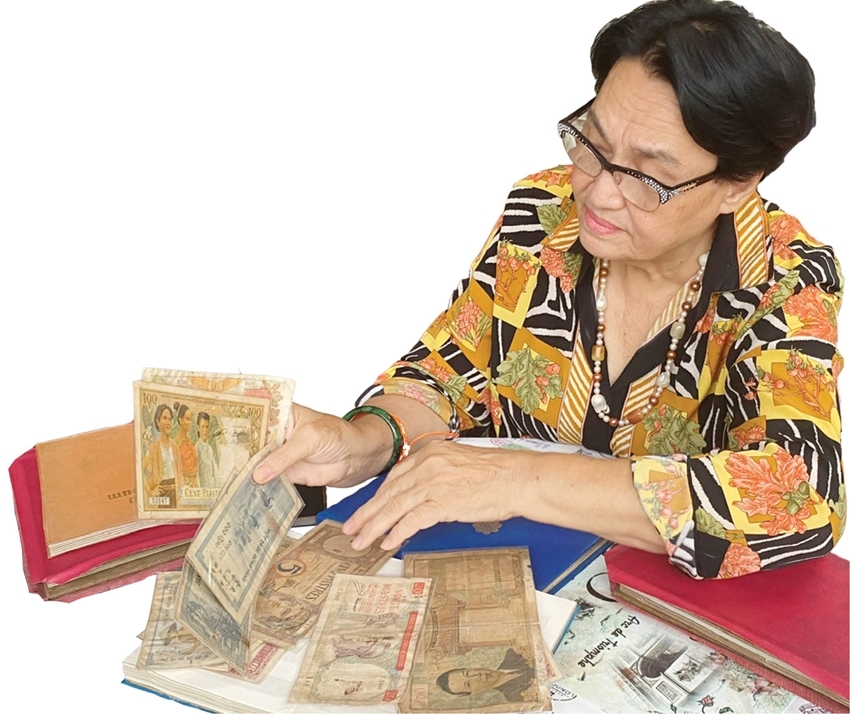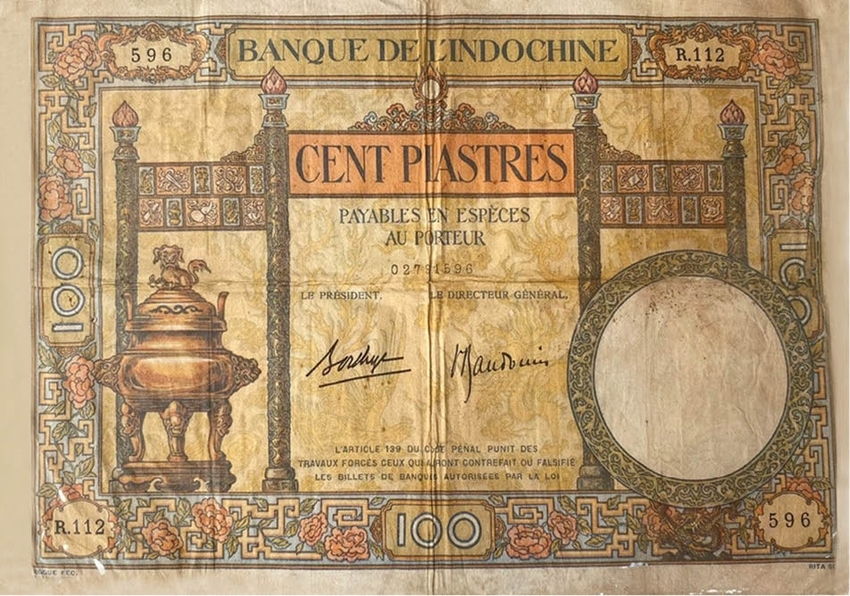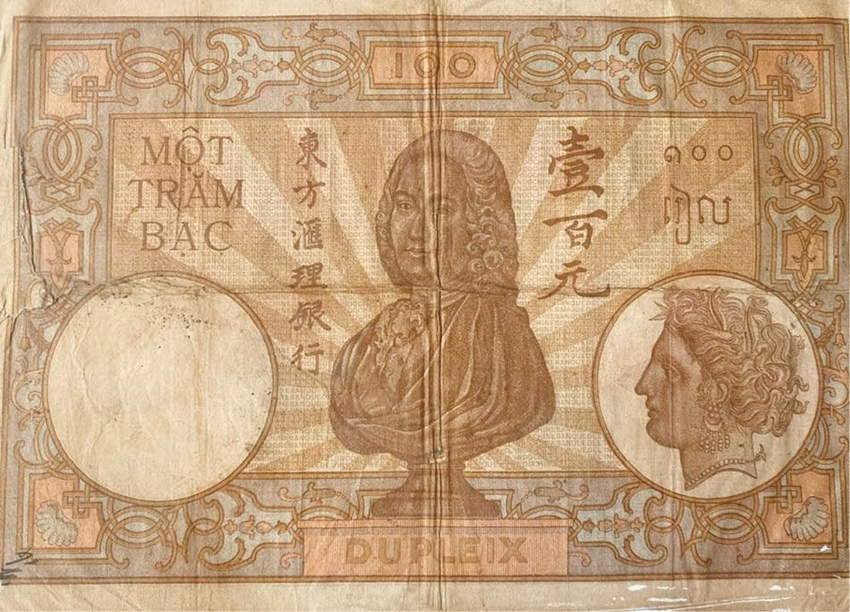 |
| Cecile Le Pham is introducing her collection |
First banknotes in Vietnam
In 2023, in a trip to France to visit her family, Cecile Le Pham brought back to Hue a collection of over 100 Indochinese banknotes and many coins issued by Banque de L'Indochine (Indochina Bank). Banknotes were of different denominations.
Those ancient Indochinese banknotes, which are also the first banknotes in Vietnam, were issued over 100 years ago and are well kept by Cecile Le Pham. Many are quite new. Besides symbols of denominations in French, Chinese, Vietnamese and Cambodian the banknotes are decorated with patterns about Vietnamese culture and people.
An interesting thing about Cecile Le Pham's collection of Indochinese currency is that there are many banknotes with images of the complex of monuments of Hue Ancient Capital. Cecile showed us with excitement the Cent Piastres banknote with Nghi Mon at Trung Dao Bridge in front of Thai Hoa Palace in the Imperial City. To the right of Nghi Mon is a bronze urn. This is the famous “Cent Piastres with the Urn” banknote circulating during 1923-1932.
 |
| The famous “Cent Piastres” banknote |
On the front side of the ''One Gold” banknote circulating in 1933-1939 are the images of a Tonkin woman wearing four-piece dress and man (a kind of traditional hat) and Minh Lau in Hieu Lang (emperor Minh Mang’s mausoleum.) On the back side reads “Dong phuong Hoi ly Ngan hang” (“Eastern Exchange Bank”) in Chinese characters and its face value in Cambodian characters, Chinese characters and Vietnamese. The main image on the back is a shirtless young man carrying two baskets of coconuts on his shoulders, hence called by the masses the “One Piastre with the Coconut Man.”
Another colorful 100-piastre banknote with the front side in French and the three girls from Cambodia, Laos and Vietnam. On the back side is the portrait of Head of State Bao Dai and Bai Dinh at emperor Khai Dinh’s Ung Lang. Or the 200-piastre banknote with the portrait of Head of State Bao Dai in another period issued by the Federal Institutes of Cambodia, Laos and Vietnam.
 |
| The back side of the 100-piastre banknote |
In addition to the portrait of Head of State Bao Dai, a special feature of many Indochinese banknotes is the image of a man wearing a striped turban. According to researcher Nguyen Anh Huy, it is the portrait of Mr. Ung Ton (i.e., Thuc Thuyen), Huong Thiet’s son and Tuy Ly Vuong Mien Trinh’s grandson. He was the first Vietnamese who studied Finance and Banking in France.
Reminding of motherland
Of the antique collectors I have met, Mrs. Cecile Le Pham is a special case. She is an entrepreneur. Though she does not study culture deeply, she has a big love for Vietnamese antiques. It is the feeling that motivates her to collect “Vietnamese things” from all over the world even though she is sometimes not knowledgeable about them. As for her, when she looks at those artifacts, she sees her motherland. “At that time, Indochinese currency was sold in abundance at an antique market near my house in France. They were sold together with currencies from other countries. Although I did not understand much about their value, I was so touched when I saw images of my motherland on banknotes, so I wanted to bring them back. The portrait of emperor Bao Dai, farmers with baskets on their shoulders, women in ao dai, or royal constructions in Hue, etc., comforted my nostalgia for Vietnam,” recalled Cecile.
The collection of Indochinese banknotes was collected by Cecile in the 1980s, starting in Saigon when she returned to Vietnam from France to visit her family. When she returned to France, she collected ancient Indochinese banknotes every time she saw them at antique markets in France. Her collection has the contribution of her son Pham Le Hong Hai. From the age of 10, he began to pay attention to collecting banknotes though he did not understand anything about them then. Every time he saw them, he bought and kept them well.
Ancient Indochinese currency is part of history because it reflects the period when the country was colonized by the French. In the history of Vietnamese currency, Indochinese banknotes were well noticed by ancient money collectors. According to Nguyen Anh Huy, the Indochinese currency experienced different stages. In the early stage, the Indochinese Bank used European decorative patterns such as images of Greek and Roman gods. When the French began to study Vietnamese culture in depth, images of the Indochina were used.
Together with the Indochinese currency, the banknotes issued by the Court of Hue were also in use. However, due to the high face value of Indochinese banknotes, they were often stored as assets. “Many Indochinese banknotes in the first stage are now very rare and valuable. Although Cecile Pham's collection lacks rare banknotes, it can be displayed to diversify her museum,” said Huy.
Cecile’s father was French. Though born and raised in Vietnam, during her childhood, Cecile attended a French boarding school, and she just came home on Tet. Raised in a Western environment, Cecile at that time did not think and act as a Vietnamese. Only when she lived abroad did she begin to feel that she was Vietnamese every time she returned to Can Tho to visit her mother. Her love for her motherland gradually grew up in her, urging her to learn about the Vietnamese history. She returned to Vietnam to work and built orphanages. That was also the reason why she collected Vietnamese antiquities from all over the world.